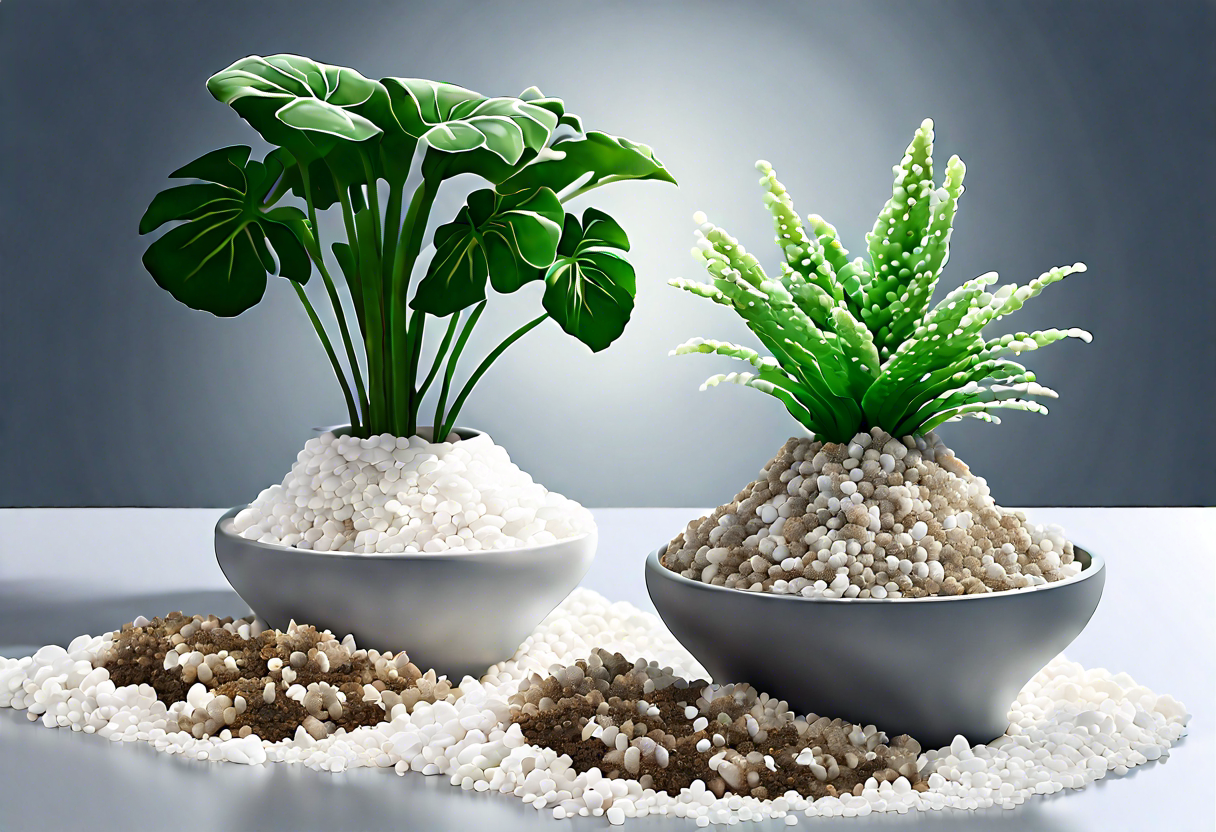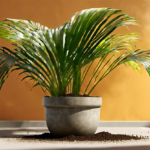Perlite and Its Benefits for Houseplants
Perlite is a lightweight mineral material that has become a popular addition to potting mixes for houseplants. It is made from volcanic glass that is heated to a high temperature, causing it to expand and form small, white, lightweight particles. The unique properties of perlite make it an excellent choice for enhancing the growth and health of houseplants.
One of the main benefits of perlite is its ability to improve drainage in potting soil. The particles of perlite have numerous tiny cavities that allow excess water to drain freely, preventing waterlogging and the risk of root rot. This is especially important for houseplants, as too much moisture can be detrimental to their overall health. By incorporating perlite into the potting mix, water is able to flow through the soil more efficiently, ensuring that the roots receive sufficient moisture without becoming waterlogged.
In addition to improving drainage, perlite also promotes better aeration in the potting mix. The cavities in the perlite particles create air pockets within the soil, allowing oxygen to reach the roots more easily. Proper oxygenation is crucial for the health of houseplants, as it helps to prevent root suffocation and encourages strong, vibrant growth. By incorporating perlite into the potting mix, you can create an environment that promotes optimal root health and development.
Perlite also provides insulation to the roots, helping to regulate soil temperature. This is particularly beneficial for houseplants that are sensitive to temperature fluctuations. The porous nature of perlite allows it to trap heat during colder periods and release it gradually, providing a more stable and favorable root environment. This insulation property also helps to protect the roots from extreme temperatures, ensuring their overall health and longevity.
Additionally, perlite is sterile and free from pests, diseases, and weed seeds. This makes it a safe and reliable additive for houseplants, without the risk of introducing harmful organisms into the potting mix. It is also chemically inert, meaning it will not alter the pH level of the soil. This is important for maintaining the proper pH balance for houseplants, as different species have specific requirements.
Perlite offers numerous benefits for houseplants. Its ability to improve drainage, enhance aeration, provide insulation, and ensure a sterile growing environment make it a valuable addition to potting mixes. By incorporating perlite, you can create optimal conditions for your houseplants, promoting their overall health and longevity.
The Importance of Vermiculite in Potting Mix for Houseplants
If you’re an avid houseplant enthusiast, you know that the right potting mix is crucial for the health and well-being of your plants. One ingredient that plays a vital role in creating the perfect potting mix is vermiculite. This natural mineral has a unique structure that benefits houseplants in various ways.
Vermiculite is a hydrated magnesium aluminum silicate mineral that is mined from the earth. It undergoes a process called exfoliation, where it is heated to a high temperature, causing it to expand and create the familiar fluffy particles that we see in potting mixes. This expansion process gives vermiculite its excellent water retention properties, making it an ideal addition to potting mixes.
One of the primary benefits of using vermiculite in potting mix is its ability to retain moisture. The expanded structure of vermiculite allows it to hold water and nutrients, releasing them slowly to the plant’s roots over time. This means that even if you forget to water your houseplants for a day or two, the vermiculite will retain enough moisture to keep the plants hydrated.
In addition to its water retention capabilities, vermiculite also helps improve aeration in the potting mix. The porous nature of vermiculite allows for better airflow in the soil, preventing compaction and ensuring that the roots have access to oxygen. This is especially important for houseplants, as oxygen is essential for root respiration, nutrient uptake, and overall plant growth.
Furthermore, vermiculite promotes root development and prevents root rot. The airy texture of vermiculite prevents the soil from becoming too compacted, allowing roots to grow and spread easily. It also helps create a well-draining environment, preventing excess water from sitting around the roots, which can lead to root rot and other fungal diseases.
When using vermiculite in potting mixes, it is important to note that it is not a standalone medium. It is best to blend vermiculite with other components like peat moss, perlite, and compost to create a well-balanced potting mix. This combination provides the optimal balance of water retention, aeration, and nutrient availability for houseplants.
Incorporating vermiculite into your potting mix is a wise choice for any houseplant enthusiast. Its water retention properties, ability to improve aeration, and promotion of root development make it an invaluable ingredient. By utilizing vermiculite, you can create an optimal growing environment for your houseplants, ensuring their health and longevity.
Mixing Perlite and Vermiculite: The Perfect Combination for Healthy Houseplants
When it comes to creating the ideal environment for your houseplants, the right combination of growing media is crucial. Two popular additives that can greatly enhance the quality of your potting mix are perlite and vermiculite. By mixing these two components together, you can create the perfect combination for healthy and thriving houseplants.
What is Perlite?
Perlite is a natural volcanic glass that is heated and expanded to create lightweight and porous particles. It is commonly used in potting mixes due to its excellent drainage properties. The porous structure of perlite allows water to flow freely through the soil, preventing waterlogged conditions that can lead to root rot. Additionally, perlite helps to prevent compaction in the potting mix, allowing air to circulate around the roots of your plants.
How Does Perlite Benefit Houseplants?
Perlite offers several benefits to houseplants. Firstly, its lightweight nature prevents the potting mix from becoming too dense, promoting healthy root growth. The improved aeration provided by perlite encourages the development of a robust root system, leading to stronger and healthier plants. Perlite also helps to regulate soil moisture levels by allowing excess water to drain away, preventing overwatering and promoting optimal root health.
The Importance of Vermiculite
Vermiculite is a mineral that is often used in potting mixes for its ability to retain moisture. It has excellent water-holding capacity, which helps to provide a consistent supply of moisture to the roots of your houseplants. Vermiculite absorbs water like a sponge and slowly releases it as the surrounding soil dries out. This ensures that your plants’ roots have access to the moisture they need, reducing the risk of underwatering. Additionally, vermiculite aids in improving soil structure, preventing compaction, and allowing for adequate root penetration.
Why Mix Perlite and Vermiculite?
By combining perlite and vermiculite in your potting mix, you can enjoy the benefits of both additives. The perlite improves drainage and prevents the soil from becoming waterlogged, while the vermiculite helps to retain moisture and promote balanced hydration for your houseplants. This combination creates a well-aerated and well-hydrated environment for your plants, ensuring optimal root development and overall plant health.
Both perlite and vermiculite into your potting mix can greatly enhance the growing conditions for your houseplants. The lightweight and porous nature of perlite improves drainage and aeration, while vermiculite helps to retain moisture and promote balanced hydration. Together, they create the perfect combination for healthy and thriving houseplants. So, the next time you’re potting your houseplants, consider incorporating both perlite and vermiculite for optimal results.
Comparing Perlite and Vermiculite: Which is Better for Your Houseplants?
Perlite and vermiculite are both widely used in gardening and horticulture, particularly when it comes to potting mix for houseplants. While they serve similar purposes, there are distinct differences between the two. Understanding these differences can help you determine which one is better suited for your specific needs.
Perlite for Houseplants
Perlite is a lightweight, volcanic glass that is processed and expanded through rapid heating. The result is a highly porous material with excellent water retention and drainage properties. This makes perlite an ideal choice for improving the overall texture and drainage capacity of potting mixes.
One of the main benefits of perlite is its ability to retain moisture while also providing adequate aeration to the roots of your houseplants. By creating air pockets within the soil, perlite allows for better root development and helps prevent waterlogged conditions that can lead to root rot.
In addition to its water-retention and aeration benefits, perlite is also sterile, meaning it is free from pests, diseases, and weed seeds. This makes it a safe choice for houseplants, as it reduces the risk of introducing unwanted organisms into the potting mix.
Vermiculite for Houseplants
Vermiculite, on the other hand, is a mineral that is mined from deposits formed by the weathering of certain rocks. It undergoes a process called exfoliation, where it expands and becomes light and spongy. Vermiculite is known for its excellent moisture-holding capacity and its ability to release nutrients slowly over time, promoting healthy growth in houseplants.
One of the main advantages of vermiculite is its ability to retain moisture in the potting mix, which can be particularly beneficial for houseplants that require consistent moisture levels, such as ferns or certain tropical plants. Vermiculite also aids in retaining essential nutrients in the soil, ensuring that your plants have access to necessary elements for their growth and development.
In addition to its moisture-retention properties, vermiculite also helps insulate the roots of your houseplants from extreme temperature fluctuations. This can be especially useful if you live in an area with fluctuating weather conditions or if you tend to overwater your plants.
Which is Better for Your Houseplants?
Choosing between perlite and vermiculite ultimately depends on your specific needs and the requirements of your houseplants. If your plants prefer well-draining soil and are prone to root rot, perlite may be the better choice. On the other hand, if your plants require consistent moisture levels and can benefit from slow-release nutrients, vermiculite might be more suitable.
In many cases, a combination of perlite and vermiculite can provide the best of both worlds. Mixing the two materials in your potting mix can create an optimal balance of moisture retention, drainage, and aeration for your houseplants, promoting healthy growth and preventing common issues associated with improper soil conditions.
Both perlite and vermiculite offer unique benefits for houseplants. Understanding their characteristics and how they can improve the soil conditions in your pots will help you make an informed decision on which one – or combination of both – is best for your specific plants and growing conditions.
Tips for Using Perlite and Vermiculite to Improve Drainage and Aeration for Houseplants
Using perlite and vermiculite in your potting mix can greatly enhance the drainage and aeration of your houseplants, ensuring their overall health and vitality. These two lightweight materials are commonly used by gardeners and horticulturists to improve soil structure and create an ideal environment for plants to thrive. Here are some tips on how to effectively use perlite and vermiculite for your houseplants:
-
Choose the Right Ratio: When incorporating perlite and vermiculite into your potting mix, it is important to find the right ratio that suits your specific plants. A commonly recommended ratio is to use equal parts of perlite, vermiculite, and regular potting soil. However, this ratio can be adjusted based on the specific needs of your plants and the moisture-retaining properties of your potting soil.
-
Enhance Drainage: Perlite is an excellent material for improving drainage. Its porous nature allows excess water to drain away from the roots, preventing waterlogging and root rot. When adding perlite to your potting mix, ensure that it is evenly distributed throughout the soil. This will create air pockets, allowing water to flow freely and ensuring that the roots receive enough oxygen.
-
Retain Moisture: Vermiculite, on the other hand, has excellent moisture-retaining properties. It absorbs water and releases it slowly to the plant roots, preventing the soil from drying out too quickly. This is especially beneficial for plants that prefer more moisture, such as tropical houseplants. Mixing vermiculite in your potting mix will help retain moisture for a longer period, reducing the frequency of watering.
-
Improve Aeration: Both perlite and vermiculite contribute to improved aeration of the potting mix. The lightweight particles create air pockets that promote root development and enhance nutrient absorption. This is particularly important for potted plants, as the restricted root space can hinder healthy growth. By incorporating perlite and vermiculite, you provide the roots with the necessary oxygen for optimal growth.
-
Consider Plant Requirements: Different plants have different requirements when it comes to drainage and moisture retention. Research the specific needs of your houseplants to determine the ideal ratio of perlite and vermiculite in your potting mix. For plants that prefer a well-drained environment, increase the ratio of perlite. For those that require more moisture, increase the ratio of vermiculite.
Perlite and vermiculite into your potting mix can significantly improve the drainage and aeration for your houseplants, leading to healthier and more vibrant plants. Remember to choose the right ratio based on your plant’s needs, ensuring that water flows freely while retaining enough moisture. With these tips, your houseplants will thrive in their new growing environment.
Conclusion
Perlite and vermiculite are two essential additives that can greatly benefit houseplants. Perlite, a natural volcanic glass, is prized for its ability to improve drainage and aeration in the soil. Its lightweight and porous nature allow excess water to drain away quickly, preventing waterlogged roots and the onset of root rot. Additionally, perlite provides insulation against extreme temperature fluctuations, protecting the delicate root systems of houseplants. Its neutral pH also ensures that it does not alter the soil’s acidity, making it suitable for a wide range of plant species.
Vermiculite, on the other hand, serves as an excellent moisture-retaining agent in potting mixes. Derived from the mineral mica, vermiculite possesses a high water-holding capacity, ensuring that plants receive a steady supply of moisture even during dry spells. This characteristic is particularly beneficial for houseplants that require consistent hydration, such as ferns or tropical plants. Furthermore, vermiculite’s ability to improve soil structure enhances root development and nutrient absorption, leading to healthier and more robust plants.
When combined, perlite and vermiculite create the perfect blend for optimal plant growth. The addition of perlite improves drainage and prevents waterlogged soil, while vermiculite ensures that moisture is retained for longer periods. This combination creates a well-balanced environment that promotes healthy root development, prevents overwatering, and minimizes the risk of fungal and bacterial infections. Houseplants potted in a mixture of perlite and vermiculite are more likely to thrive and flourish, showcasing vibrant foliage and abundant blooms.
While both materials provide valuable benefits, determining which is better for your houseplants ultimately depends on their specific needs. If you have plants that require excellent drainage and aeration, such as succulents or cacti, perlite may be the ideal choice. On the other hand, if your plants demand constant moisture and nutrient availability, vermiculite becomes the preferred option. In some cases, a combination of both perlite and vermiculite may provide the best of both worlds, catering to a wider range of plant requirements.
To make the most of perlite and vermiculite in enhancing drainage and aeration, it is essential to follow a few tips. Firstly, ensure that the ratio of perlite and vermiculite to the potting mix is appropriate for the specific needs of your plants. Generally, a blend of one-third perlite or vermiculite to two-thirds potting mix is recommended. Additionally, during the repotting process, carefully mix the perlite or vermiculite into the potting soil, ensuring an even distribution. Moreover, regularly monitor the moisture levels in the soil to prevent overwatering or underwatering.
By incorporating perlite and vermiculite in the right proportions and following proper guidelines, you can significantly improve the overall health and vitality of your houseplants. These lightweight additives work in harmony to create a well-drained and aerated environment, preventing common issues associated with poor soil structure. Whether you have drought-tolerant plants or those that thrive in consistently moist conditions, perlite and vermiculite offer valuable benefits that can transform your houseplant collection into a flourishing oasis.


